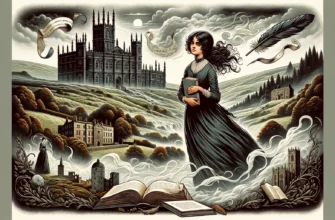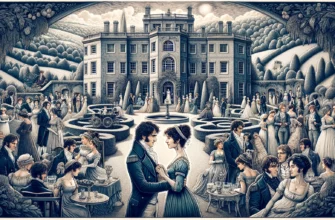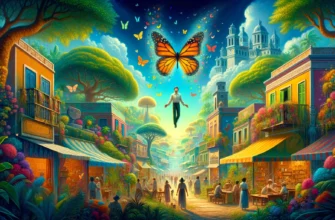The Life and Times of Joseph Conrad
Joseph Conrad was born in 1857 in Berdychiv, Ukraine, then part of the Russian Empire, to Apollo Korzeniowski, a writer, translator, political activist, and Ewa Bobrowska.
His early life was marked by turmoil and loss, including his parents’ exile and death, which instilled in him a profound sense of isolation and an outsider’s perspective. Despite these early hardships, Conrad was fluent in Polish, French, and, later, English, showcasing his linguistic talents that would prove crucial in his literary career.
At 17, Conrad left for Marseille to embark on a maritime career, dramatically shaping his worldview and literary themes. His twenty years at sea exposed him to the harsh realities of colonialism, the vastness of the ocean, and the diverse cultures and human conditions that would later populate his novels.
Notably, his journey to the Belgian Congo in 1890 as a steamship captain provided firsthand experiences of the horrors and absurdities of imperialism, profoundly influencing his masterpiece, “Heart of Darkness.”
Conrad’s persistent health and financial struggles throughout his life influenced his literary tone and narrative style. After settling in England in the late 1890s, he published his first novel, Almayer’s Folly, in 1895.
Despite initial indifference from the public and critics, Conrad persisted, eventually earning acclaim for his rich prose, intricate narratives, and profound moral questioning. His works, including “Lord Jim” (1900), “The Secret Agent” (1907), and “Under Western Eyes” (1911), reflect his deep insights into human nature and the complexities of civilization and barbarism.
In exploring the depths of human nature and the complexities of imperialism, Joseph Conrad’s “Heart of Darkness” stands out among the best classic novels of all time. Its profound narrative and timeless themes continue to resonate, making it an essential read for those seeking to understand the human condition and the historical impacts of colonialism.
Historical Context of Heart of Darkness
“Heart of Darkness” is set against late 19th-century European imperialism, a period marked by the aggressive colonization and exploitation of African territories. The novel specifically references the Congo Free State, a private colony under the brutal regime of King Leopold II of Belgium.
During this time, the Congo was subjected to horrendous abuses as the local population was forced into labor for the extraction of rubber and ivory, leading to widespread suffering and death.
The international outcry against the atrocities in the Congo was significant, leading to one of the first major human rights movements of the 20th century. Reports from missionaries, journalists, and whistleblowers like E.D. Morel and Roger Casement brought the horrors to global attention, prompting demands for reform.
This context is critical in understanding “Heart of Darkness” as Conrad’s narrative is not just a fictional journey into the African interior but also a profound critique of the dehumanizing effects of imperialism.
Despite the novel’s sad themes and setting, it is crucial to recognize that Conrad’s depiction of Africa and Africans has sparked debates and criticisms, notably from Nigerian writer Chinua Achebe, who accused Conrad of dehumanizing Africans and reducing them to mere backdrops for a critique of Europe.
This criticism invites readers to reflect on the novel’s portrayal of otherness and the complexities of interpreting a text from a different era with its historical and cultural biases.
Overview of Heart of Darkness
“Heart of Darkness” unfolds as a frame narrative, a story within a story. The central tale is told by Charles Marlow, a seasoned seaman, to his fellow sailors aboard the Nellie, anchored on the Thames River.
Marlow recounts his appointment as a steamship captain for a Belgian trading company and his journey up the Congo River to retrieve Mr. Kurtz, an ivory trader who has gone mysteriously silent.
Throughout his journey, Marlow encounters inefficiency and brutality in the European trading outposts. The deeper he travels into the Congo, the more he witnesses the horrors of colonial exploitation and the disintegration of European morals in the wilderness.
Once a romantic and talented man, Kurtz embodies the jungle’s corrupting isolation and power. His infamous final words, “The horror! The horror!” encapsulate the profound darkness and moral ambiguity that Marlow confronts.
The narrative’s complexity is further enriched by Conrad’s use of darkness, not just as a physical absence of light but as a metaphor for the unknown, the feared, and the morally ambiguous. The Congo River is a powerful symbol, representing the journey into the inner depths of the human psyche and the heart of darkness within civilization itself.
Themes and Symbolism in Heart of Darkness
One of the central themes of “Heart of Darkness” is the critique of imperialism and the illusion of European civilization. Conrad exposes the hollowness of the so-called “civilizing mission” and the brutality inflicted in the name of progress and profit.
The novel reveals the thin veneer of civilization that easily gives way to savagery when removed from familiar social structures, a theme that resonates with Conrad’s disillusionment with European imperial endeavors.
Another significant theme is the exploration of darkness, both literal and metaphorical. The novel delves into the darkness of the African jungle, representing the fear of the unknown and the subconscious.
However, it also explores the darkness within humanity—the capacity for moral decay, madness, and evil when individuals are stripped of societal norms and constraints. Kurtz’s character embodies this descent into moral darkness, highlighting the fragile nature of civilization and the complexity of human morality.
Symbolism is employed masterfully throughout the novel, with the Congo River serving as a metaphor for the journey into the deepest recesses of human nature. The fog that frequently envelops the river signifies the ambiguity and lack of clarity in understanding the true nature of civilization and savagery.
Kurtz’s Intended and his African mistress represent the conflicting images of womanhood and the duality of perception and reality. Through these symbols, Conrad weaves a dense narrative that invites readers to ponder the profound questions of morality, civilization, and the inherent darkness within the human soul.
Narrative Technique and Literary Devices
Joseph Conrad‘s “Heart of Darkness” is renowned for its intricate narrative structure and the sophisticated use of literary devices. The novel is a remarkable example of a frame narrative, where the story of Charles Marlow is told by an anonymous narrator aboard the ship Nellie on the Thames, adding layers to the narrative perspective.
This structure creates a distance between the reader and Marlow’s experiences, allowing Conrad to explore the limitations and complexities of storytelling and the subjective nature of truth and reality.
Conrad’s use of an unreliable narrator in Marlow further enriches the narrative. Marlow’s interpretation of events and characters, particularly Kurtz, is subjective and fraught with biases and uncertainties.
This narrative choice invites readers to question the reliability of Marlow’s account and actively interpret the novel’s meaning. The use of ambiguity and fragmented narrative reflects the confusion and moral ambiguity that Marlow experiences in the Congo, mirroring the chaos and complexity of the imperial enterprise.
Imagery and symbolism are central to Conrad’s narrative technique, with recurring images of darkness, light, and fog reinforcing the themes of ignorance, enlightenment, and ambiguity. The contrast between light and dark is not just a physical reality but also symbolizes the characters’ moral and existential dilemmas.
Conrad’s use of dense, evocative language and his ability to evoke the oppressive atmosphere of the Congo set the tone for the novel, making the setting not just a backdrop but an active participant in the narrative.
Reception and Legacy of Heart of Darkness
Upon its publication in 1899, “Heart of Darkness” received a mixed reception. While some praised Conrad’s vivid imagery and profound philosophical inquiries, others were baffled by the novel’s complex narrative and bleak outlook.
However, over time, “Heart of Darkness” has gained stature and is now considered a seminal work in the Western literary canon. It is admired for its profound insights into the human psyche and imperialism’s dark legacy.
The novel’s influence extends beyond literature, inspiring countless artists, writers, and filmmakers. Its themes of moral ambiguity, the corruption of power, and the thin line between civilization and savagery resonate across cultures and epochs.
“Heart of Darkness” has also been the subject of intense scholarly debate, particularly in postcolonial studies, where it is critiqued for its portrayal of Africa and Africans and lauded for its critique of European imperialism.
Despite its controversial aspects, the novel’s legacy is undeniable. It continues to be widely read, studied, and discussed, serving as a powerful reminder of the complexities of human nature and the dark corners of history.
The debates surrounding “Heart of Darkness” are a testament to its enduring relevance and its ability to provoke reflection and discussion about the most profound and troubling aspects of the human experience.
Heart of Darkness in Modern Media
The profound impact of “Heart of Darkness” is not confined to the literary world; its themes and narrative have influenced various forms of modern media.
Perhaps the most notable adaptation is Francis Ford Coppola’s 1979 film “Apocalypse Now,” which reinterprets Conrad’s story in the context of the Vietnam War, showcasing the novel’s timeless relevance and its powerful critique of the madness of imperialism and the darkness within the human soul.
Other adaptations and references to “Heart of Darkness” can be found in numerous films, television shows, and other artistic mediums. These adaptations often explore the novel’s themes of moral ambiguity, the corrupting influence of power, and the thin line between civilization and savagery, demonstrating the novel’s enduring appeal and capacity to resonate with contemporary audiences and issues.
The novel’s influence on modern media underscores its status as a cultural touchstone, a work that continues to inspire and provoke. Whether through direct adaptation or thematic exploration, “Heart of Darkness” remains a powerful presence in modern storytelling, its narrative and themes echoing in new contexts and formats, attesting to its universal relevance and profound insights into the human condition.
Comparative Studies: Heart of Darkness and Other Works
“Heart of Darkness” is often studied in conjunction with other literary works that explore themes of imperialism, morality, and human nature. A notable comparison is with Rudyard Kipling’s “The White Man’s Burden,” which presents a starkly different view of imperialism.
Kipling’s poem urges the Western powers to take up the colonial enterprise as a noble, albeit burdensome, mission, contrasting sharply with Conrad’s bleak portrayal of the imperialist endeavor in “Heart of Darkness.”
Another critical comparison is with Chinua Achebe’s “Things Fall Apart,” which offers an African perspective on colonialism’s impacts. Achebe’s novel counters the depictions of Africa and Africans in “Heart of Darkness,” providing a nuanced portrayal of African society and culture and the devastating effects of European imperialism.
The dialogue between these works enriches the understanding of the complexities and consequences of imperialism and the representation of different cultures in literature.
Comparative studies of “Heart of Darkness” with other works highlight Conrad’s unique contribution to literary discussions of imperialism and human nature and foster a broader understanding of the colonial and postcolonial eras’ historical, cultural, and ethical contexts.
These comparisons invite readers to engage with the complexities of history and literature and to consider the diverse perspectives and voices that shape our understanding of the past and present.








